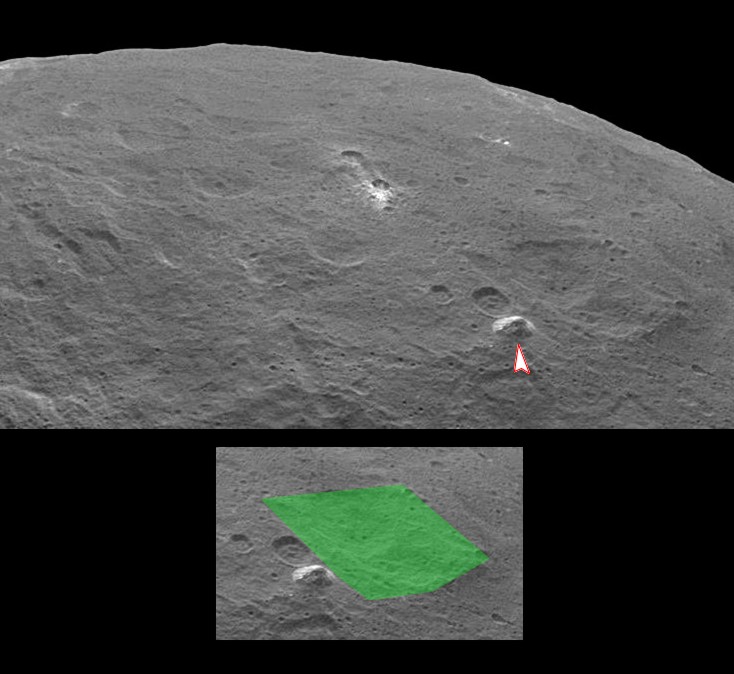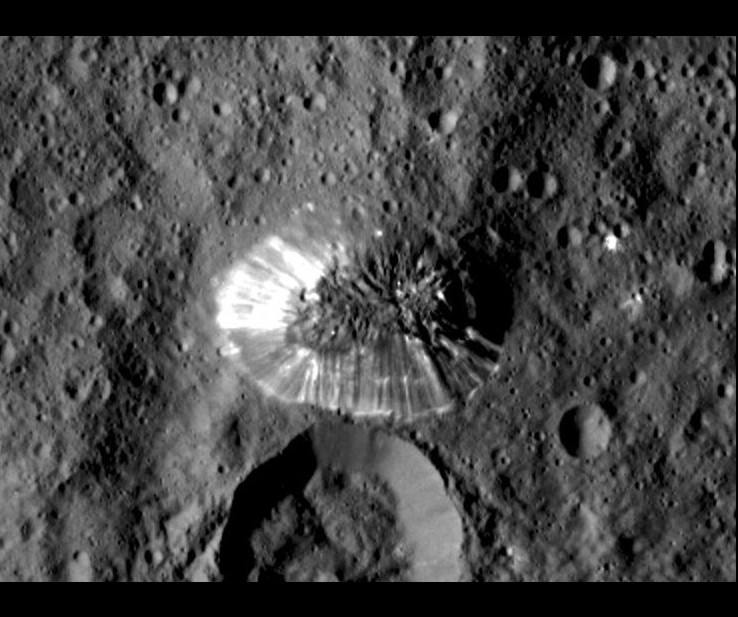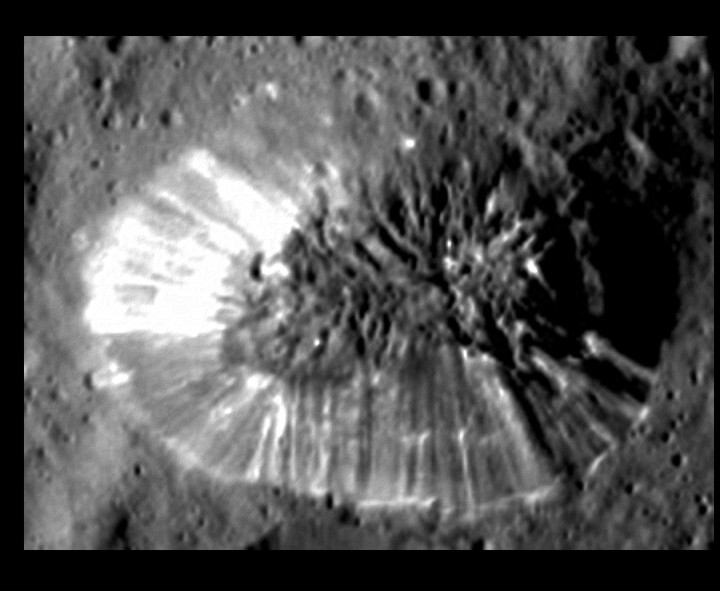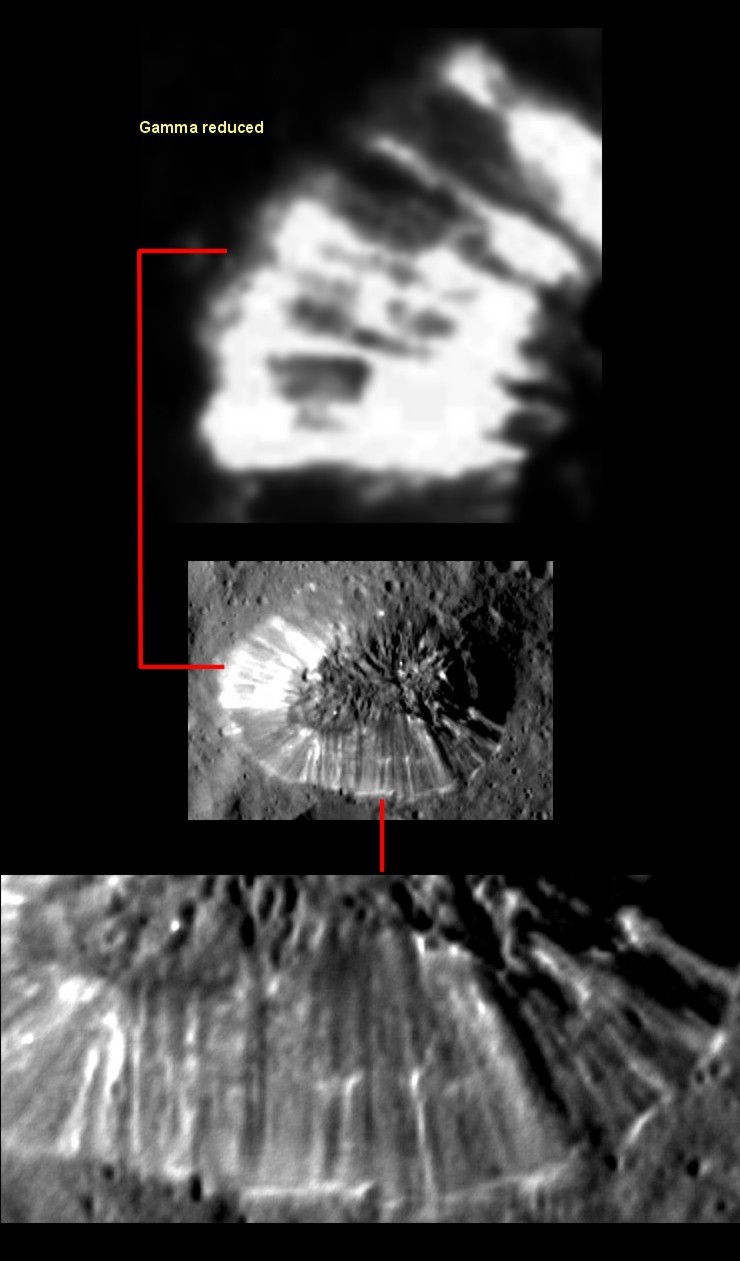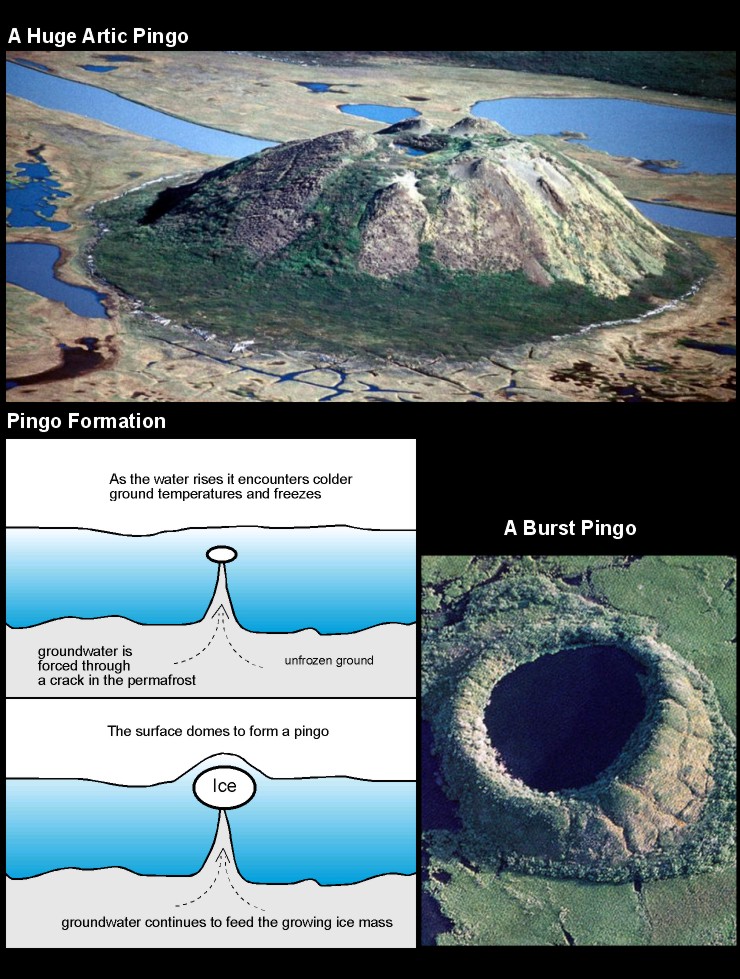|
Cydonia Quest
The Occasional Journal C
Entry No. 13 - 28th August 2015
NASA's Ceres Pyramid
The Spring and Summer of 2015 have been very notable in the annals of space exploration. In April the Dawn spacecraft reached the dwarf planet Ceres in the Asteroid Belt. Since then it has been slowly spiralling closer to Ceres, which has allowed for a slow increase in the resolution of the images it is sending back to Earth.
On the 14th of July the New Horizons spacecraft flew by tiny Pluto and discovered bizarre ranges of "ice mountains" there. Readers who have been following images provided in conjunction with Richard Hoagland's new radio show will know that some of these mountains seem hollowed out. Much higher resolution images of Pluto from the mission are expected in September 2015, so any Cydonia Quest article about Pluto can wait until then, (see µµµ and µµµ for Pluto imagery).
Ceres has also provided a couple of anomalies. The best known is the Ceres "Lights", which are a cluster of small highly reflective patches in Occator Crater that are so intense that they can be seen far away in space as a bright beacon, (see µµµ and µµµ).
The other anomaly discovered on Ceres is what NASA instantly dubbed the Ceres "Pyramid". The Pyramid is a four mile high, conical, flat topped mountain. It is Ceres's only real mountain and is totally disproportionate to the 590 mile diameter of Ceres. Unlike the ancient, dark, crater covered surface of Ceres, the Pyramid looks fresh and bright. c Is the Ceres Pyramid an Arcology?
A higher resolution image of the Ceres Pyramid has just been published. The rest of this journal article will explore the possibility that the Pyramid is an artificial structure, (see µµµ).
The image below shows a wide angled shot of the Pyramid and gives an impression of its unique nature on the Ceres surface. The small appended image shows how it sits on the edge of a curious four sided depression. Is this the result of artificial subsidence?
The next illustration shows the new image of the Pyramid at its actual published resolution. (Readers can use the zoom function on their browsers to increase the size of this image). Even at this resolution it is possible to see straight parallel "beams" running vertically up its slopes. There are even some signs of "cross-beams" joining these "beams" together. This creates some rectangular geometry on the slopes of the Pyramid.
Whereas every inch of the surrounding Ceres surface is covered with meteorite craters, there are very few of these on the fresh looking Pyramid. In geological time the Pyramid must therefore be much younger than the rest of the surface of Ceres. It arrived after the craters were formed.
Another indication that the Pyramid is a relatively young feature is in the NASA annotation for this image, which notes: "...Its perimeter is sharply defined, with almost no accumulated debris at the base of the brightly streaked slope...". This is a way of saying that the slopes of the Pyramid haven't had time to collapse yet - despite being quite steep.
Yet another indicator of the Pyramid's youthfulness is that it sits right on the rim of a large impact crater. If the Pyramid had existed before the crater was blown out then it would have been blasted by a barrage of large boulders. There is no evidence on the Pyramid for this.
All-in-all the Pyramid's appearance is alien to its surroundings and looks like it was just plonked down onto the surface. The following picture is an enlargement of the previous one and makes it easier to see the curious parallel 3D geometry on its slopes.
The "flat top" of the Ceres Pyramid is actually very crumpled. This suggests the slopes once extended much higher and joined at a pointy peak - but that this peak then crumbled downwards into the centre of the Pyramid. That might be possible if there were hollow spaces within the Pyramid to allow such subsidence to occur. That in turn would fit in with the idea of the Pyramid being a truly huge arcology. (An arcology is a single self contained habitat able to house the population of a town or city).
Finally, to further aid readers in considering parallel and rectangular geometry on the slopes of the Pyramid, the following poster has been prepared. The left side slope has been "washed out" by its gleaming reflectiveness. In the poster the gamma brightness of this slope has been adjusted to allow the rectangular and cross-hatching features on its surface to be seen better.
What kind of a natural process might have created the Pyramid?
It's become part of the Cydonia Quest tradition to try and think of an unusual geological explanation for anomalies such as NASA's Ceres Pyramid.
One possible scenario is that the Pyramid is a 21,000 foot high "ice volcano". The current model for Ceres's composition has a water ice mantle sandwiched between a rocky core and a crust of icy rock. The ice mantle may be warm enough to be watery or slushy in places.
The internal pressures of Ceres might be great enough to force this water up through a weak spot in the crust where it freezes and continuously builds up a mountain of ice. This would explain how the Pyramid has arrived on the scene long after the surface it sits on. It would also explain why the Pyramid's slopes are shiny . It's the gleam of ice. However, there are some tough questions to be asked of such a scenario.
(1) Why is the Pyramid the only huge "ice volcano" in the whole history Ceres? The crust of Ceres appears to have many weak spots as evidenced by long cracks in its surface in some images. There should be opportunities for the formation of more ice volcanoes.
(2) Is there enough hydraulic pressure to force a rising column of water to a height 21,000 feet above the surface of Ceres?
It should also be noted that there is nothing intrinsic in the ice volcano scenario to explain the 3D geometry seen on the slopes of the Ceres Pyramid.
There is a process in the Arctic regions of Earth that mimics the "ice volcano" scenario. This is the Arctic's Pingo hills. Pingo hills form when upwelling water from a spring moves up into the frozen permafrost and freezes there before it can get to the surface. Over time a bigger and bigger dome of ice grows under the permafrost forcing the ground to bulge upwards into a conical hill. The biggest of these Pingo hills can reach heights of 200 feet - still very tiny compared to the Pyramid.
Eventually the growing dome of ice bursts through the overlayer of permafrost and is exposed. This marks the death of the Pingo because the ice melts once it is exposed to the summer air. This leads to the collapse of the Pingo into a formation that looks like a volcanic caldera.
All this is illustrated in the poster below.
Even if the Ceres Pyramid is a natural feature it would definitely be one of the most wondrous marvels of our solar system.
This latest image of the Ceres Pyramid was taken at an altitude of over 900 miles. The Dawn spacecraft will eventually be orbiting three times closer than that with a commensurate increase in image resolution. Will the Pyramid then have more surprises for us? Might it look even more like a slowly crumbling super-arcology built of metal or glass - or a reinforced ice in the mode of Pykrete? (See µµµ).
c µ Click this "Stargate" to return to Journal main page µ Return to the main Mars page µ Return to the Cydonia Quest main page c
|
